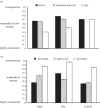Taking sociality seriously: the structure of multi-dimensional social networks as a source of information for individuals
- PMID: 22734054
- PMCID: PMC3385678
- DOI: 10.1098/rstb.2012.0113
Taking sociality seriously: the structure of multi-dimensional social networks as a source of information for individuals
Abstract
Understanding human cognitive evolution, and that of the other primates, means taking sociality very seriously. For humans, this requires the recognition of the sociocultural and historical means by which human minds and selves are constructed, and how this gives rise to the reflexivity and ability to respond to novelty that characterize our species. For other, non-linguistic, primates we can answer some interesting questions by viewing social life as a feedback process, drawing on cybernetics and systems approaches and using social network neo-theory to test these ideas. Specifically, we show how social networks can be formalized as multi-dimensional objects, and use entropy measures to assess how networks respond to perturbation. We use simulations and natural 'knock-outs' in a free-ranging baboon troop to demonstrate that changes in interactions after social perturbations lead to a more certain social network, in which the outcomes of interactions are easier for members to predict. This new formalization of social networks provides a framework within which to predict network dynamics and evolution, helps us highlight how human and non-human social networks differ and has implications for theories of cognitive evolution.
Figures



Similar articles
-
Social cognition on the Internet: testing constraints on social network size.Philos Trans R Soc Lond B Biol Sci. 2012 Aug 5;367(1599):2192-201. doi: 10.1098/rstb.2012.0121. Philos Trans R Soc Lond B Biol Sci. 2012. PMID: 22734062 Free PMC article. Review.
-
Sociality and the evolution of intelligence.Trends Cogn Sci. 2004 May;8(5):195-7. doi: 10.1016/j.tics.2004.03.002. Trends Cogn Sci. 2004. PMID: 15120676 Review.
-
Social bonds of female baboons enhance infant survival.Science. 2003 Nov 14;302(5648):1231-4. doi: 10.1126/science.1088580. Science. 2003. PMID: 14615543
-
Why understanding multiplex social network structuring processes will help us better understand the evolution of human behavior.Evol Anthropol. 2020 May;29(3):102-107. doi: 10.1002/evan.21850. Evol Anthropol. 2020. PMID: 32544306
-
From temporal network data to the dynamics of social relationships.Proc Biol Sci. 2021 Sep 29;288(1959):20211164. doi: 10.1098/rspb.2021.1164. Epub 2021 Sep 29. Proc Biol Sci. 2021. PMID: 34583581 Free PMC article.
Cited by
-
Formidable females redux: male social integration into female networks and the value of dynamic multilayer networks.Curr Zool. 2021 Feb;67(1):49-57. doi: 10.1093/cz/zoaa041. Epub 2020 Jul 29. Curr Zool. 2021. PMID: 33654490 Free PMC article.
-
Embodied cognitive evolution and the cerebellum.Philos Trans R Soc Lond B Biol Sci. 2012 Aug 5;367(1599):2097-107. doi: 10.1098/rstb.2012.0112. Philos Trans R Soc Lond B Biol Sci. 2012. PMID: 22734053 Free PMC article.
-
Protocol to record multiple interaction types in small social groups of birds.STAR Protoc. 2022 Nov 3;3(4):101814. doi: 10.1016/j.xpro.2022.101814. eCollection 2022 Dec 16. STAR Protoc. 2022. PMID: 36386874 Free PMC article.
-
Female social structure influences, and is influenced by, male introduction and integration success among captive rhesus macaques (Macaca mulatta).Behaviour. 2021 Sep;158(11):1007-1042. doi: 10.1163/1568539x-bja10109. Epub 2021 Jul 23. Behaviour. 2021. PMID: 36176722 Free PMC article.
-
High-resolution tracking of hyrax social interactions highlights nighttime drivers of animal sociality.Commun Biol. 2022 Dec 15;5(1):1378. doi: 10.1038/s42003-022-04317-5. Commun Biol. 2022. PMID: 36522486 Free PMC article.
References
-
- Tooby J., Cosmides L. 2005. Conceptual foundations of evolutionary psychology. In Handbook of evolutionary psychology (ed. Buss D.), pp. 5–67 Hoboken, NJ: Wiley
-
- Buss D. (ed.) 2005. The handbook of evolutionary psychology. Hoboken, NJ: Wiley
-
- Pinker S. 2003. How the mind works. London, UK: Penguin
-
- Dewey J. 1896. The reflex arc concept in psychology. Psychol. Rev. 3, 357–370 10.1037/h0070405 (doi:10.1037/h0070405) - DOI - DOI
-
- Dewey J. 1898/1976. Lectures on psychological and political ethics. New York, NY: Hafner Press
Publication types
MeSH terms
LinkOut - more resources
Full Text Sources

